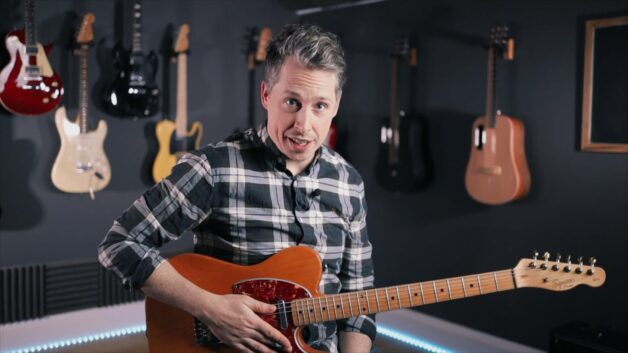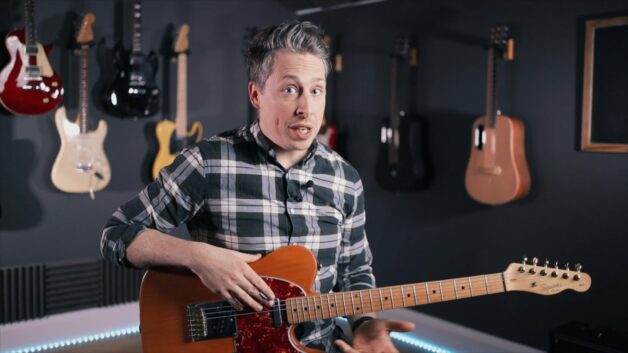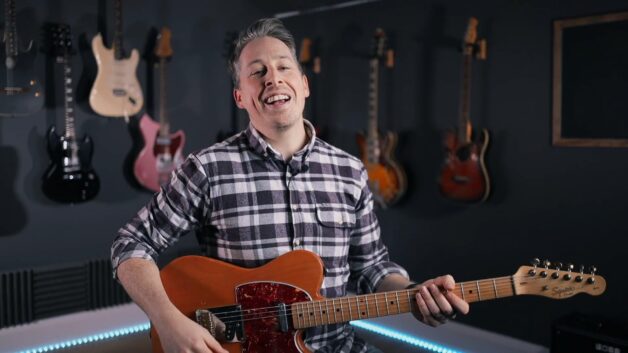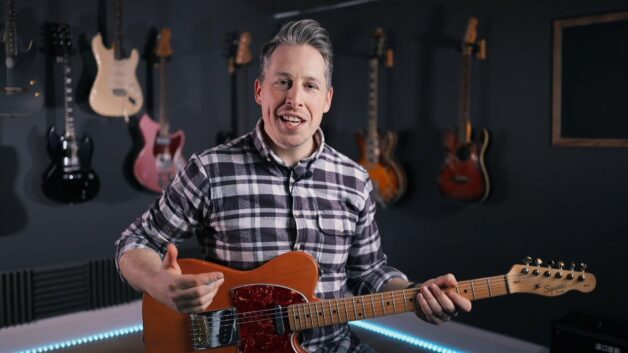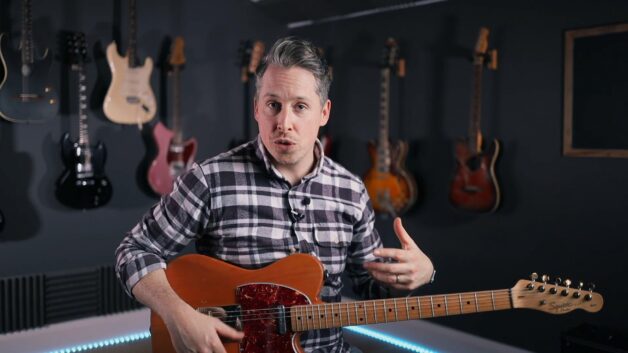Module 2 - Lesson 7
Introduction to Jazz Guitar
 Julien Bitoun
Julien Bitoun
- Beginner
- Jazz
-
MODULE 2
Introduction to Guitar Music Styles - Introduction to Folk Guitar
- Introduction to Blues Guitar
- Introduction to Pop Guitar
- Introduction to Rock Guitar
- Introduction to Metal Guitar
- Introduction to Funk Guitar
- Introduction to Jazz Guitar
Recommended songs
| Title | Album | Type | |
|---|---|---|---|
| Alice in Wonderland | Guitar Duet | ||
| All of Me | Guitar Duet | ||
| All the Things You Are | Guitar Duet | ||
| Autumn Leaves | Guitar Duet | ||
| Bag's Groove | Guitar Duet | ||
Beautiful Love

|
Guitars, Bass & Backing Track | ||
Blue Bossa

|
Guitars, Bass & Backing Track | ||
Blue Monk

|
Guitars, Bass & Backing Track | ||
| But Not For Me | Guitar Duet | ||
| Bye Bye Blackbird | Guitar Duet | ||
| Caravan | Guitar Duet | ||
| Chameleon | Guitar Duet | ||
Doxy

|
Guitars, Bass & Backing Track | ||
| Line For Lyons | Guitar Duet | ||
| My Little Suede Shoes | Guitar Duet | ||
Night and Day

|
Guitars, Bass & Backing Track | ||
Now's The Time

|
Guitars, Bass & Backing Track | ||
| Out of Nowhere | Guitar Duet | ||
| So What | Solo Guitar | ||
| Softly as in a Morning Sunrise | Guitar Duet | ||
Someday My Prince Will Come

|
Guitars, Bass & Backing Track | ||
St. Thomas

|
Guitars, Bass & Backing Track | ||
| Summertime | Guitar Duet | ||
| Sweet Georgia Brown | Guitar Duet | ||
Take the "A" Train

|
Guitars, Bass & Backing Track | ||
| The Song Is You | Guitar Duet | ||
| There Will Never Be Another You | Guitars, Bass & Backing Track | ||
| Tune Up | Guitar Duet | ||
| Watermelon Man | Guitar Duet | ||
| Yesterdays | Guitar Duet |
How to Play Jazz Music on Guitar: Your Guide to Jazz Rhythm and Chords
Why Jazz Guitar is Both Challenging and Rewarding
Learning how to play jazz music on guitar can seem daunting at first, especially when you begin encountering chords you’ve never even heard of before, like minor 7ths, half-diminished chords, or dominant 13ths. These chords often intimidate beginners because they require stretching fingers into unfamiliar shapes. Yet, this initial struggle quickly becomes rewarding as your ear adjusts and you start hearing those colorful chords in your favorite jazz tunes.
Historically, jazz guitar has evolved through a fascinating mix of styles and innovators. Jazz itself emerged in the southern United States alongside blues, back in the late 19th century. Guitarists first played a supporting role, mostly rhythm-oriented, until Charlie Christian changed everything in Benny Goodman’s band during the big band era. Christian essentially pioneered the guitar solo, inspiring future jazz legends like Wes Montgomery and Jim Hall.
Understanding Jazz Chords and Rhythms (Without the Headache)
When starting jazz guitar, one of the common hurdles beginners face is mastering jazz chords. These chords, like the Major 7 (think of the dreamy opening chord in “Girl from Ipanema”), Minor 7, Dominant 7, and the more advanced 9th, 11th, and 13th chords, create that signature jazz sound. If these names seem foreign, don’t worry, most guitarists start exactly where you are.
But a small tip: avoid the temptation to rush through these chords. Beginners often make the mistake of trying to learn too many chords too quickly. Instead, focus on quality, not quantity. Spend some time really internalizing basic jazz voicings like the Major 7 or Minor 7. Practice transitioning smoothly between these chords before moving onto more advanced shapes.
Jazz rhythms also differ significantly from rock or pop. You’ll quickly notice a swing or triplet feel sometimes referred to as “la pompe”, famously associated with gypsy jazz guitarist Django Reinhardt. This rhythmic feel might initially challenge you, especially if you’re used to strict eighth-note strumming. But it’s worth taking the time to internalize it, as swing rhythms are foundational to mastering jazz guitar.
Finding the Right Guitar Sound: Practical Tips
Jazz guitarists traditionally favor warm, smooth, and rounded tones. Achieving this usually involves specific equipment choices, though you don’t necessarily need a vintage archtop guitar to get started. While a fully hollow archtop guitar (used by legends like Wes Montgomery) produces an authentically warm tone, beginners often get great results with semi-hollow guitars or even solid-body guitars equipped with humbuckers.
If you’re using a solid-body guitar, switch to your neck (rhythm) pickup and slightly roll back the tone knob to soften the high frequencies. This simple tweak instantly produces a more jazz-appropriate sound. A common mistake beginners make here is setting the guitar tone too bright or trebly, resulting in an overly harsh sound that’s uncharacteristic of jazz.
Occasionally, you might find famous jazz guitarists who successfully incorporated brighter tones (think of fusion-era Pat Metheny or John McLaughlin), whose tones are distinctive yet not traditional. These exceptions prove that jazz guitar can accommodate many sounds, but beginners typically benefit from starting with darker, warmer tones.
Essential Jazz Standards to Kickstart Your Learning
Choosing suitable jazz songs early on can make a massive difference. Consider learning accessible yet authentic jazz standards like:
- “Autumn Leaves”, famous for its gentle chord progression.
- “All of Me”, ideal for practicing dominant 7th chords.
- “Watermelon Man”, perfect for exploring jazz-funk rhythms.
- “Nuages” by Django Reinhardt, excellent for mastering the “la pompe” rhythm.
These songs provide a practical gateway into understanding jazz harmony and rhythm without overwhelming complexity.
Remember, jazz guitar is about embracing both structure and improvisation. Although initially challenging, once you’re comfortable with the fundamentals, jazz guitar playing becomes deeply rewarding. So, dive into those chords, explore some classic jazz tunes, and you’ll quickly understand why learning how to play jazz music on guitar is both a journey and a joy.


